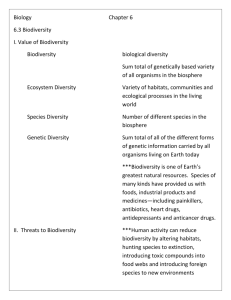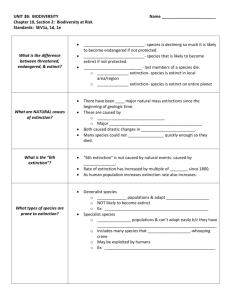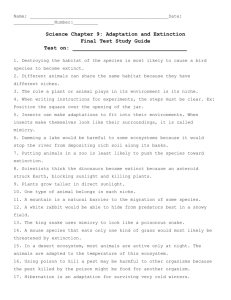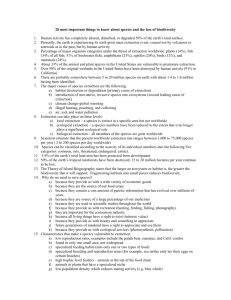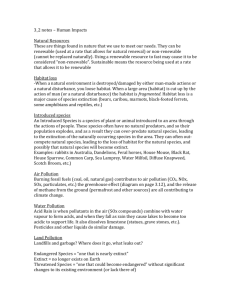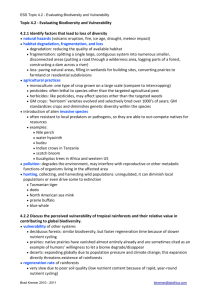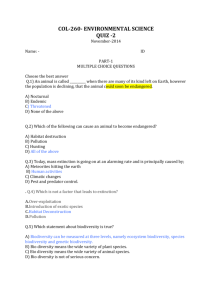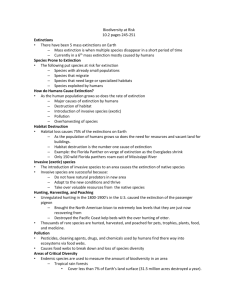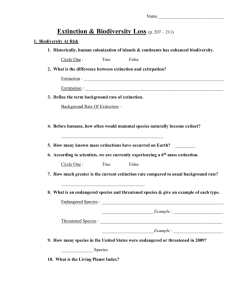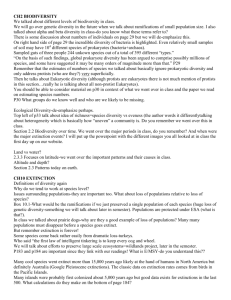Topic 4 Practice Questions Marking Scheme (a) (i) Northern Andes 1
advertisement
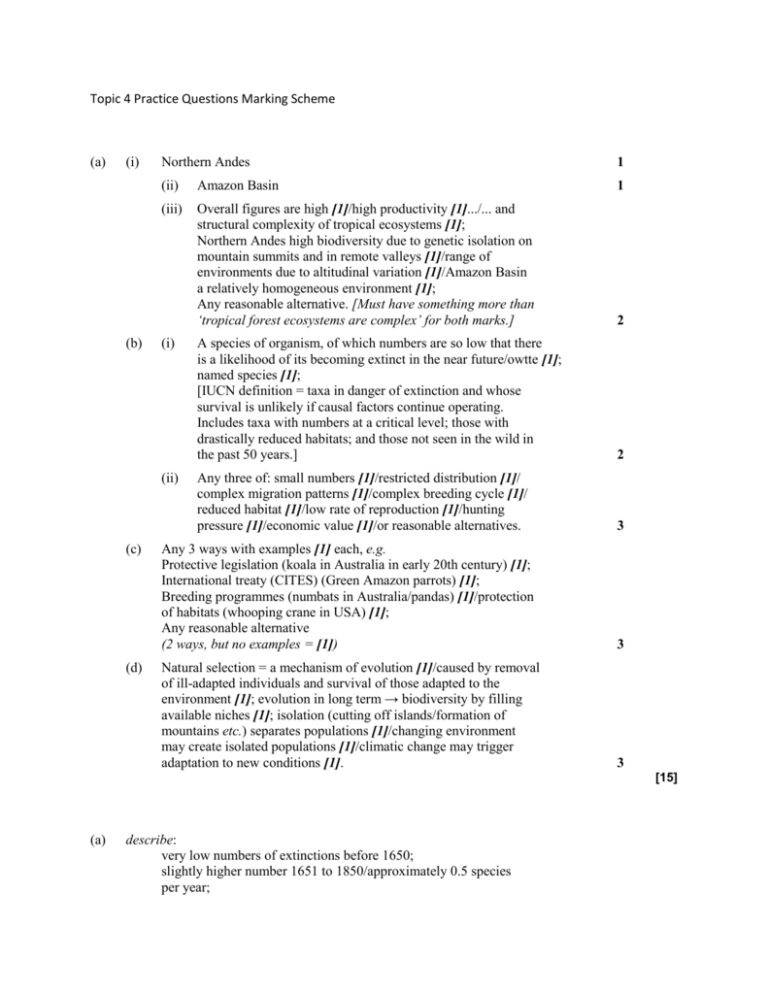
Topic 4 Practice Questions Marking Scheme (a) (i) (b) Northern Andes 1 (ii) Amazon Basin 1 (iii) Overall figures are high [1]/high productivity [1].../... and structural complexity of tropical ecosystems [1]; Northern Andes high biodiversity due to genetic isolation on mountain summits and in remote valleys [1]/range of environments due to altitudinal variation [1]/Amazon Basin a relatively homogeneous environment [1]; Any reasonable alternative. [Must have something more than ‘tropical forest ecosystems are complex’ for both marks.] 2 A species of organism, of which numbers are so low that there is a likelihood of its becoming extinct in the near future/owtte [1]; named species [1]; [IUCN definition = taxa in danger of extinction and whose survival is unlikely if causal factors continue operating. Includes taxa with numbers at a critical level; those with drastically reduced habitats; and those not seen in the wild in the past 50 years.] 2 Any three of: small numbers [1]/restricted distribution [1]/ complex migration patterns [1]/complex breeding cycle [1]/ reduced habitat [1]/low rate of reproduction [1]/hunting pressure [1]/economic value [1]/or reasonable alternatives. 3 (i) (ii) (c) (d) Any 3 ways with examples [1] each, e.g. Protective legislation (koala in Australia in early 20th century) [1]; International treaty (CITES) (Green Amazon parrots) [1]; Breeding programmes (numbats in Australia/pandas) [1]/protection of habitats (whooping crane in USA) [1]; Any reasonable alternative (2 ways, but no examples = [1]) 3 Natural selection = a mechanism of evolution [1]/caused by removal of ill-adapted individuals and survival of those adapted to the environment [1]; evolution in long term → biodiversity by filling available niches [1]; isolation (cutting off islands/formation of mountains etc.) separates populations [1]/changing environment may create isolated populations [1]/climatic change may trigger adaptation to new conditions [1]. 3 [15] (a) describe: very low numbers of extinctions before 1650; slightly higher number 1651 to 1850/approximately 0.5 species per year; (b) (c) (d) rapid increase 1851 to 1950/approximately 2.5 per year; decrease in extinction rate since 1951 to approximately one species per annum; 2 max explain: extinction rate before 1850 low as human effect on biodiversity low as population pressure on environment relatively low; extinctions before 1850 not fully recorded; extinction rate 1851 to 1950 much higher due to rapid human population increase; and rapid rate of habitat loss; decrease in extinction rate since 1951 due to greater efforts to protect endangered species and ecosystems; or many vulnerable species already extinct; any other reasonable points; 3 max low total numbers/long or complex migration route/specialised habitat/specialised food sources/widely hunted or otherwise used by humans/low reproduction rate/large number of predators/susceptibility to disease/limited distribution/ catastrophe such as flooding or meteor impact; any other reasonable points; Responses need two factors per mark. Factors must be specific to extinction of organisms. No credit for vague answers such as “global warming” or “degradation of environment”. 2 max endangered: species in danger of becoming extinct in the immediate future because their numbers have declined to a critical level; extinct: species believed to no longer exist alive; 2 max Any reasonable example: reasons must be appropriate to example. [1] for name and [2] for reasons e.g. name: Dodo; reasons: confined to small island (Mauritius); extreme tameness; hunting as a source of food by visiting sailors; destruction of forest habitats; competition with introduced organisms, e.g. pigs; 3 max Note: recent research has suggested that dodos were not very tame and that the flesh was unpleasant to taste; thus habitat destruction and introduction of pigs (and rats) were probably most significant factors. However, the points given above are widely mentioned in the literature and may be considered acceptable responses. (e) (i) [1] for name, [1] for brief description e.g. Kakadu National Park, Northern Territory, Australia; tropical savanna with extensive wetlands; 2 max (ii) (f) Any reasonable examples, but must have some evaluation for full [5] marks. For above example: measures: designation as World Heritage Area by UNESCO; involvement of Aboriginal people in management; concentration of visitor pressure, campsites, into limited areas; strict protection of flora and fauna by law; international agreements with Japan, China to protect migratory birds; attempts to eliminate introduced species; 3 max evaluation: considerable success, as measured by visitor numbers; and protection of habitats and biodiversity; success due to use of modern scientific techniques and traditional land management; and due to use of local, national and international measures; 2 max genetic diversity represents the variety of genetic material in a gene pool or population, habitat diversity is the range of different habitats or ecological niches in an ecosystem, community or biome/OWTTE 1 max [20]




